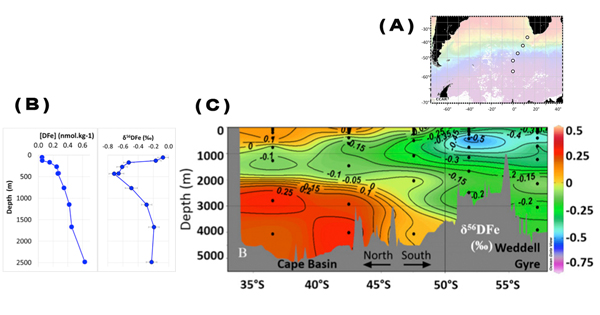Dissolved iron isotopes reveal that distinct processes are controlling this micronutrient distribution in the ocean
Abadie and co-workers propose new dissolved iron concentration and isotopic composition distributions (DFe and ICFe respectively) along the Bonus-Goodhope IPY section (GIPY4), in the Atlantic sector of the Southern Ocean. DFe vertical profiles display a continuous increase with depth (see figure B), classically interpreted as due to biological uptake at the surface followed by remineralization at depth. However, heterogeneous profiles of ICFe (see figure B) suggest a more complicated story driven by distinct processes, discussed here for the first time. Indeed, the authors demonstrate that in the intermediate waters, DFe primarily originates from remineralization of organic matter and the redistribution of this regenerated DFe through mixing. Moreover it is also due to horizontal advection of DFe released by reducing sediments of the nearby South African coast. The scheme changes deeper, where abiotic processes are dominating the DFe distribution as for example non-reductive release of DFe from lithogenic particles. This last process would add an additional source to the global oceanic DFe budget, which should be considered in the biogeochemical models. In addition, it suggests that the oceanic DFe budget could be more sensitive than previously thought to continental erosion, particle transport, and dissolved/particle interactions.

Figure: (A) Position of the 5 stations sampled for iron isotopes during the Bonus-Goodhope IPY GEOTRACES cruise; (B) Examples of profiles for dissolved iron concentration (DFe) and dissolved iron isotopic composition (expressed by δ56DFe) obtained in one of the 5 stations sampled (other stations show similar patterns); Iron isotopes show a very sharp minimum in intermediate depths (i.e. between about 200 and 1500 m below the surface). The contrast between these intermediate depths and the deep ocean (3000-5000 m) demonstrates that two different processes dominate dissolved iron sources in the ocean at these two levels. (C) Dissolved iron isotopic composition (δ56DFe) along the Bonus-Goodhope section. Negative values (in cold colours, blue, green) indicate iron that is naturally enriched in light isotopes, while high values (in warm colours, red, orange) indicate heavy iron isotopes enrichment. Click here to view the figure larger.
Reference:
Abadie, C., Lacan, F., Radic, A., Pradoux, C., Poitrasson F. (2017) Iron isotopes reveal distinct dissolved iron sources and pathways in the intermediate versus deep Southern Ocean, PNAS, DOI: 10.1073/pnas.1603107114
